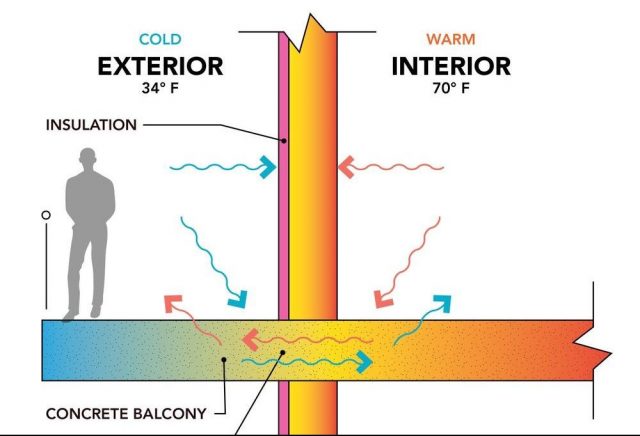Essentially, thermal bridging refers to heat energy lost through uninsulated materials such as doors, windows, and timber and metal frames, which has a negative impact on the overall performance of the building envelope system.
To fully understand this, you need understand the basics of insulation and how heat is retained or lost within a building. You can refresh your memory by checking out our beginners guide or insulation for dummies. Now that you’re all caught up, it’s time to dive deeper into thermal bridging and explain it in more detail.
As mentioned above, thermal bridging is when heat energy is lost in a building. Thermal bridges are paths that heat can pass along, regardless of the insulation that you’ve installed. This occurs when your insulation layer is bypassed by a very conductive material allowing heat to be transferred through walls, ceilings, or floors. Every house needs to be assessed for thermal bridges when being built to help minimise the effect that it has. This is done to ensure that you are getting the more out of your insulation and able to keep your home warmer for longer in the colder months.
Thermal bridges should be avoided at all costs where possible. It reduces the effectiveness of the insulation installed, regardless of how high the R-value is. As a result of this, it increases your energy spend, as you will find yourself spending more money running the heating to keep your home warm. There are also other downsides to thermal bridges that can affect your health and the safety of the building. If there are indeed thermal bridges in a building system, there is a higher chance of condensation, mould, and rot forming. This is damaging to the materials surrounding it and can harm those living in the building as it can attract unwanted pests.
During the building process, the thermal bridging will be calculated to assess the overall rating of the building. Calculations use to be done by adding the individual component R-value’s together and selecting the climate zone based on the location. You would then consider the direction of the heat flow. Now, a more complex calculation is required. The following points are as follows:
- The type of framing used in the build
- Height, spacing, and flange width of framing members
- External finish and internal lining types
- Thickness of framing and insulation used
Luckily, there are some ways that can help reduce the amount of thermal bridging in a home. Double glazing your windows is a good idea to help keep the heat in. They are more conductive than single glazed windowpanes and the heat will take slower to leave. Another option is using external facing doors with built-in insulative properties and making sure they’re sealed around correctly.
Most importantly, it’s a good idea to have a well-insulated home with no thermal bridging. Without insulation, it allows any thermal bridges to become more effective, leaving your home cold and uninviting. No Gap Insulation can offer you a free quote within 24 hours to get you started.



